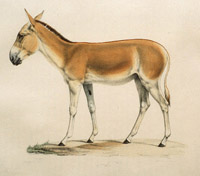
Erforschung biologischer Ressourcen der Mongolei / Exploration into the Biological Resources of Mongolia, ISSN 0440-1298
Date of this Version
2007
Document Type
Article
Citation
Erforschung biologischer Ressourcen der Mongolei (Halle/Saale) 10 (2007): 117-132. Results of the Mongolian-German Biological Expeditions since 1962, No. 284.
Abstract
There are collected materials on morphology, reproduction rate, and mortality of Dschiggetajs Equus h. hemionus between 2001 and 2006 in the South Gobi of Mongolia. It were found 794 skeletons of wild asses, 95% of these were pouched, ⅔ of them in winter coat. Pouching was also located in the protected areas of this region. The main living resources of Equus hemionus are registered in the South eastern Gobi. For the first time statistical data on morphology measurements of body length, tail and tuft, ear length, and hoofs are given. There are no significant differences between the sexes. The reproduction rate differed in the years 2003 to 2006 between 23% and 7.5% in dependence of weather and feeding conditions as well as the fitness of the mares. In two reference areas of Manlaj Sum and Bordzongijn Gobi we found in 4 years per 1 km2 2.1 to 4.1 shot wild asses. All sources of population decrease are known. Now the politicians have to develop new strategies for better protection of this endangered species. The International Nature Conservation and the International community are waiting for progress in this unacceptable situation.
Included in
Asian Studies Commons, Biodiversity Commons, Desert Ecology Commons, Environmental Sciences Commons, Nature and Society Relations Commons, Other Animal Sciences Commons, Population Biology Commons, Terrestrial and Aquatic Ecology Commons, Zoology Commons


Comments
Copyright 2007, Martin-Luther-Universität Halle Wittenberg, Halle (Saale). Used by permission.